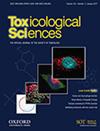利用化学空间复合网络揭开多肽溶血毒性的面纱
IF 3.4
3区 医学
Q2 TOXICOLOGY
引用次数: 0
摘要
肽是一种很有前途的治疗药物。然而,血液毒性阻碍了它们的潜力。了解多肽的血液毒性对于开发安全有效的多肽治疗药物至关重要。在这里,我们利用化学空间复合网络(CSN)来揭示多肽的血液毒性。CSNs 是根据肽的理化性质和结构特征可视化和分析肽之间关系的强大工具。我们从包含 2004 种溶血肽的 StarPepDB 数据库中构建了 CSN,并探讨了七种不同(不)相似性测量方法对网络拓扑和聚类(群落)分布的影响。我们的研究结果表明,每个 CSN 都能提取正交信息,从而增强了主题发现和富集过程。我们发现了 12 个共识溶血主题,其氨基酸组成显示赖氨酸、亮氨酸和缬氨酸残基含量高,而天冬氨酸、蛋氨酸、组氨酸、天冬酰胺和谷氨酰胺含量低。此外,物理化学特性也被用来描述溶血肽群/群落的特征。为了直接从肽序列预测溶血活性,我们构建了多查询相似性搜索模型(MQSSM),其结果优于基于机器学习(ML)的前沿模型,展示了强大的血液毒性预测能力。总之,这种新颖的硅学方法以复杂网络科学为核心策略,开发了稳健的模型分类器,描述了化学空间的特征,并从溶血肽中发现了新的主题。这将有助于加强具有潜在治疗活性和低毒性的多肽的设计/选择。本文章由计算机程序翻译,如有差异,请以英文原文为准。
Unraveling the Hemolytic Toxicity Tapestry of Peptides using Chemical Space Complex Networks
Peptides have emerged as promising therapeutic agents. However, their potential is hindered by hemotoxicity. Understanding the hemotoxicity of peptides is crucial for developing safe and effective peptide-based therapeutics. Here, we employed chemical space complex networks (CSNs) to unravel the hemotoxicity tapestry of peptides. CSNs are powerful tools for visualizing and analyzing the relationships between peptides based on their physicochemical properties and structural features. We constructed CSNs from the StarPepDB database, encompassing 2004 hemolytic peptides, and explored the impact of seven different (dis)similarity measures on network topology and cluster (communities) distribution. Our findings revealed that each CSN extracts orthogonal information, enhancing the motif discovery and enrichment process. We identified 12 consensus hemolytic motifs, whose amino acid composition unveiled a high abundance of lysine, leucine, and valine residues, while aspartic acid, methionine, histidine, asparagine and glutamine were depleted. Additionally, physicochemical properties were used to characterize clusters/communities of hemolytic peptides. To predict hemolytic activity directly from peptide sequences, we constructed multi-query similarity searching models (MQSSMs), which outperformed cutting-edge machine learning (ML)-based models, demonstrating robust hemotoxicity prediction capabilities. Overall, this novel in silico approach uses complex network science as its central strategy to develop robust model classifiers, to characterize the chemical space and to discover new motifs from hemolytic peptides. This will help to enhance the design/selection of peptides with potential therapeutic activity and low toxicity.
求助全文
通过发布文献求助,成功后即可免费获取论文全文。
去求助
来源期刊

Toxicological Sciences
医学-毒理学
CiteScore
7.70
自引率
7.90%
发文量
118
审稿时长
1.5 months
期刊介绍:
The mission of Toxicological Sciences, the official journal of the Society of Toxicology, is to publish a broad spectrum of impactful research in the field of toxicology.
The primary focus of Toxicological Sciences is on original research articles. The journal also provides expert insight via contemporary and systematic reviews, as well as forum articles and editorial content that addresses important topics in the field.
The scope of Toxicological Sciences is focused on a broad spectrum of impactful toxicological research that will advance the multidisciplinary field of toxicology ranging from basic research to model development and application, and decision making. Submissions will include diverse technologies and approaches including, but not limited to: bioinformatics and computational biology, biochemistry, exposure science, histopathology, mass spectrometry, molecular biology, population-based sciences, tissue and cell-based systems, and whole-animal studies. Integrative approaches that combine realistic exposure scenarios with impactful analyses that move the field forward are encouraged.
 求助内容:
求助内容: 应助结果提醒方式:
应助结果提醒方式:


